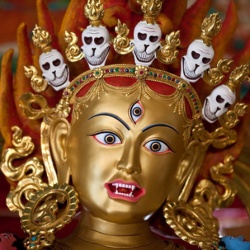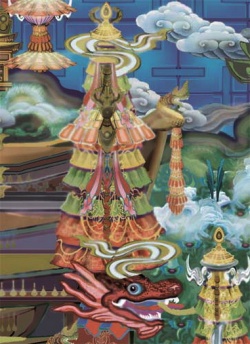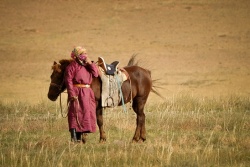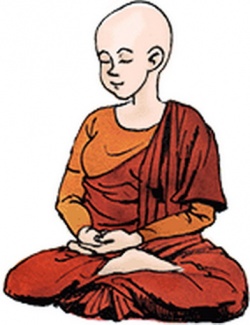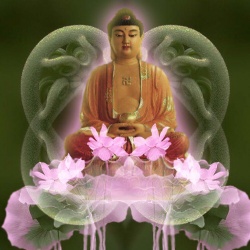Difference between revisions of "Jodo Shinshu Buddhist Etiquette"
| Line 1: | Line 1: | ||
| − | + | <nomobile>{{DisplayImages|3475|150|2689|947|587|2574|303|4335}}</nomobile> | |
| Line 10: | Line 10: | ||
| − | The {{Wiki|purpose}} of {{Wiki|etiquette}} in the [[lives]] of [[Buddhists]] becomes clear, we must put into [[action]] the reverence and [[gratitude]] which we [[feel]] for [[Amida Buddha]]. In [[teaching]] small children, then, it should be enough to convey this [[feeling]] of reverence and [[gratitude]], and the bare basic [[forms]] of {{Wiki|etiquette}}. Children will learn through the examples set by their [[teachers]]. | + | The {{Wiki|purpose}} of {{Wiki|etiquette}} in the [[lives]] of [[Buddhists]] becomes clear, we must put into [[action]] the reverence and [[gratitude]] which we [[feel]] for [[Amida Buddha]]. In [[teaching]] small children, then, it should be enough to convey this [[feeling]] of reverence and [[gratitude]], and the bare basic [[forms]] of {{Wiki|etiquette}}. |
| + | |||
| + | Children will learn through the examples set by their [[teachers]]. | ||
| + | |||
| Line 16: | Line 19: | ||
| − | [[Gassho]] means to put the hands together. The palms of both hands are placed together with the fingers and thumbs extended and with the Ojuzu (rosary) encircling both hands and held lightly between the thumbs and the fingers. Both elbows should be fairly close to the [[body]] and the hands should be at mid-chest level. To [[bow]] during the [[gassho]], the hands should be held steady, while the [[body]] is bent forward from the hips and then back to the upright position. | + | [[Gassho]] means to put the hands together. |
| + | |||
| + | |||
| + | |||
| + | The palms of both hands are placed together with the fingers and thumbs extended and with the [[Ojuzu]] (rosary) encircling both hands and held lightly between the thumbs and the fingers. | ||
| + | |||
| + | Both elbows should be fairly close to the [[body]] and the hands should be at mid-chest level. | ||
| + | |||
| + | To [[bow]] during the [[gassho]], the hands should be held steady, while the [[body]] is bent forward from the hips and then back to the upright position. | ||
| + | |||
[[Gassho]] is the natural expression of reverence and [[gratitude]]. | [[Gassho]] is the natural expression of reverence and [[gratitude]]. | ||
| Line 24: | Line 36: | ||
| − | The Ojuzu should be treated with the utmost [[respect]] at all times. At home it should be kept in a special place, such as in a drawer near the [[family]] [[shrine]]. At other times, the [[Buddhist]] should carry the Ojuzu in the purse or in the coat pocket so that it will always be available. During the service, the Ojuzu should be held in the left hand. | + | The [[Ojuzu]] should be treated with the utmost [[respect]] at all times. |
| + | |||
| + | At home it should be kept in a special place, such as in a drawer near the [[family]] [[shrine]]. | ||
| + | |||
| + | At other times, the [[Buddhist]] should carry the [[Ojuzu]] in the purse or in the coat pocket so that it will always be available. | ||
| + | |||
| + | During the service, the Ojuzu should be held in the left hand. | ||
| + | |||
| + | The [[Ojuzu]] encircles the hand during [[gassho]] [[symbolizing]] [[Oneness]]. | ||
| − | |||
| Line 32: | Line 51: | ||
| − | |||
| + | When burning [[incense]], walk up to the front of the [[shrine]] and [[bow]] at a distance of about two steps in front of the [[incense]] table. | ||
| + | |||
| + | Step up to the table and with the right hand take a pinch of powdered [[incense]] and drop it into the [[incense-burner]]. | ||
| + | |||
| + | [[Gassho]] and [[bow]]. Take two or three steps backward, [[bow]] and return to the seat. | ||
| + | Oshoko is the [[acceptance]] of transience and fulfillment in [[life]]. | ||
| − | |||
| − | |||
| + | GENERAL BEHAVIOUR IN THE [[TEMPLE]] | ||
| − | + | {{Wiki|Etiquette}} in general requires us to refrain from talking out of turn; from whispering and chitchatting when in a large group; | |
| − | The Seiten and [[Gatha]] [[books]] should be handled with proper care. Before and after the [[chanting]] the [[book]] should be raised to the {{Wiki|forehead}} as a gesture of [[appreciation]] and reverence to the [[words of the Buddha]]. | + | and from poking or otherwise annoying our friends, especially when attending a service at the [[temple]]. |
| + | |||
| + | [[Attention]] should be directed to the service being conducted. | ||
| + | |||
| + | |||
| + | |||
| + | USE OF THE [[SEITEN]] AND [[GATHA]] BOOKS | ||
| + | |||
| + | |||
| + | The [[Seiten]] and [[Gatha]] [[books]] should be handled with proper care. Before and after the [[chanting]] the [[book]] should be raised to the {{Wiki|forehead}} as a gesture of [[appreciation]] and reverence to the [[words of the Buddha]]. | ||
| Line 50: | Line 82: | ||
ENTERING AND LEAVING THE [[HONDO]] (MAIN HALL) | ENTERING AND LEAVING THE [[HONDO]] (MAIN HALL) | ||
| − | The [[Hondo]] should be entered quietly and with reverence. Upon entering, [[gassho]] facing the [[shrine]]. Take your seat and quietly wait for the service to begin. Avoid being late and try not to enter the [[Hondo]] during the [[meditation]] service. | + | |
| + | The [[Hondo]] should be entered quietly and with reverence. | ||
| + | |||
| + | Upon entering, [[gassho]] facing the [[shrine]]. | ||
| + | |||
| + | Take your seat and quietly wait for the service to begin. | ||
| + | |||
| + | Avoid being late and try not to enter the [[Hondo]] during the [[meditation]] service. | ||
| + | |||
Before leaving the [[Hondo]], when the service is over, turn to face the [[shrine]] and [[gassho]] before leaving. | Before leaving the [[Hondo]], when the service is over, turn to face the [[shrine]] and [[gassho]] before leaving. | ||
| Line 57: | Line 97: | ||
RECITING THE [[NEMBUTSU] | RECITING THE [[NEMBUTSU] | ||
| − | As Jodo Shinshu is based on the realization of the Nembutsu, the importance of reciting it correctly cannot be under-emphasized. Namu Amida Butsu should be recited clearly and correctly. | + | As [[Jodo Shinshu]] is based on the realization of the [[Nembutsu]], the importance of reciting it correctly cannot be under-emphasized. |
| + | |||
| + | [[Namu Amida Butsu]] should be recited clearly and correctly. | ||
| Line 63: | Line 105: | ||
LISTENING TO THE READING OF SACRED WRITINGS | LISTENING TO THE READING OF SACRED WRITINGS | ||
| − | The minister or lay reader often reads excerpts from the writings of Shinran Shonin, or the Epistles of Rennyo shonin (Gobunsho) before delivering the sermon. The congregation should sit with heads bowed and listen attentively to the words. When the speaker bows in greeting the congregation, or when he/she bows after the talk, the congregation should bow back. | + | The minister or lay reader often reads excerpts from the writings of [[Shinran Shonin]], or the [[Epistles of Rennyo shonin]] ([[Gobunsho]]) before delivering the sermon. |
| + | |||
| + | The congregation should sit with heads bowed and listen attentively to the words. | ||
| + | |||
| + | When the speaker bows in greeting the congregation, or when he/she bows after the talk, the congregation should bow back. | ||
| Line 69: | Line 115: | ||
LEADING THE CONGREGATION IN READING | LEADING THE CONGREGATION IN READING | ||
| − | Leading the congregation in reading, whether it be sacred writings or excerpts from the sutras, is an honor and therefore should be performed in that spirit. [[Gassho]] and [[bow]] towards the [[shrine]] before beginning the reading. Hold the [[book]] with both hands and read slowly and distinctly so that the congregation can follow together. | + | Leading the congregation in reading, whether it be sacred writings or excerpts from the [[sutras]], is an honor and therefore should be performed in that spirit. |
| + | |||
| + | [[Gassho]] and [[bow]] towards the [[shrine]] before beginning the reading. | ||
| + | |||
| + | Hold the [[book]] with both hands and read slowly and distinctly so that the congregation can follow together. | ||
{{R}} | {{R}} | ||
http://shinmission_sg.tripod.com/id15.html | http://shinmission_sg.tripod.com/id15.html | ||
[[Category:Jōdo Shinshū]] | [[Category:Jōdo Shinshū]] | ||
Revision as of 22:35, 14 November 2015
What is etiquette?
Etiquette in general is concerned with the refinement of human behavior in its relationship with other human beings. Buddhist etiquette is concerned with the refinement of our behavior in relation to Amida Buddha.
The purpose of etiquette in the lives of Buddhists becomes clear, we must put into action the reverence and gratitude which we feel for Amida Buddha. In teaching small children, then, it should be enough to convey this feeling of reverence and gratitude, and the bare basic forms of etiquette.
Children will learn through the examples set by their teachers.
Gassho means to put the hands together.
The palms of both hands are placed together with the fingers and thumbs extended and with the Ojuzu (rosary) encircling both hands and held lightly between the thumbs and the fingers.
Both elbows should be fairly close to the body and the hands should be at mid-chest level.
To bow during the gassho, the hands should be held steady, while the body is bent forward from the hips and then back to the upright position.
Gassho is the natural expression of reverence and gratitude.
The Ojuzu should be treated with the utmost respect at all times.
At home it should be kept in a special place, such as in a drawer near the family shrine.
At other times, the Buddhist should carry the Ojuzu in the purse or in the coat pocket so that it will always be available.
During the service, the Ojuzu should be held in the left hand.
The Ojuzu encircles the hand during gassho symbolizing Oneness.
BURNING OF INCENSE (OSHOKO)
When burning incense, walk up to the front of the shrine and bow at a distance of about two steps in front of the incense table.
Step up to the table and with the right hand take a pinch of powdered incense and drop it into the incense-burner.
Gassho and bow. Take two or three steps backward, bow and return to the seat.
Oshoko is the acceptance of transience and fulfillment in life.
GENERAL BEHAVIOUR IN THE TEMPLE
Etiquette in general requires us to refrain from talking out of turn; from whispering and chitchatting when in a large group;
and from poking or otherwise annoying our friends, especially when attending a service at the temple.
Attention should be directed to the service being conducted.
USE OF THE SEITEN AND GATHA BOOKS
The Seiten and Gatha books should be handled with proper care. Before and after the chanting the book should be raised to the forehead as a gesture of appreciation and reverence to the words of the Buddha.
ENTERING AND LEAVING THE HONDO (MAIN HALL)
The Hondo should be entered quietly and with reverence.
Upon entering, gassho facing the shrine.
Take your seat and quietly wait for the service to begin.
Avoid being late and try not to enter the Hondo during the meditation service.
Before leaving the Hondo, when the service is over, turn to face the shrine and gassho before leaving.
RECITING THE [[NEMBUTSU]
As Jodo Shinshu is based on the realization of the Nembutsu, the importance of reciting it correctly cannot be under-emphasized.
Namu Amida Butsu should be recited clearly and correctly.
LISTENING TO THE READING OF SACRED WRITINGS
The minister or lay reader often reads excerpts from the writings of Shinran Shonin, or the Epistles of Rennyo shonin (Gobunsho) before delivering the sermon.
The congregation should sit with heads bowed and listen attentively to the words.
When the speaker bows in greeting the congregation, or when he/she bows after the talk, the congregation should bow back.
LEADING THE CONGREGATION IN READING
Leading the congregation in reading, whether it be sacred writings or excerpts from the sutras, is an honor and therefore should be performed in that spirit.
Gassho and bow towards the shrine before beginning the reading.
Hold the book with both hands and read slowly and distinctly so that the congregation can follow together.

